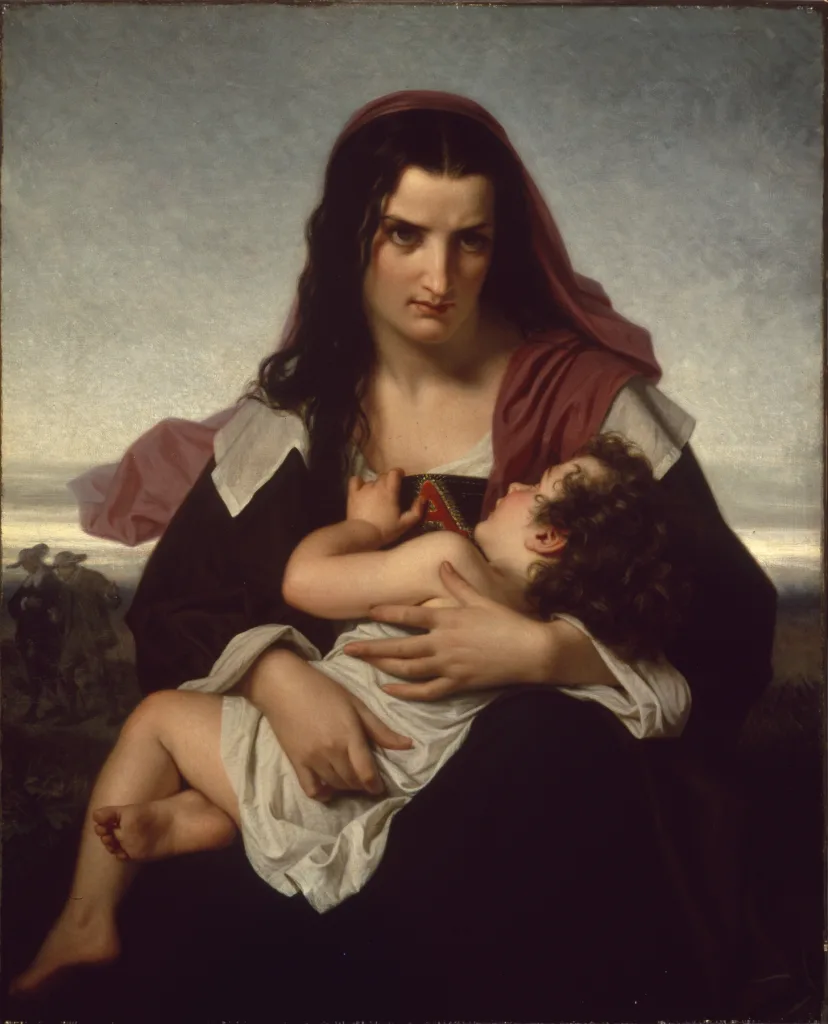Arthur Dimmesdale is a central character in Nathaniel Hawthorne’s novel, “The Scarlet Letter.” He is a highly respected minister in the Puritan community of Boston, known for his powerful sermons and devout piety. However, beneath his pious facade lies a deep and tormenting secret that eats away at his soul.
Dimmesdale’s sin is revealed early on in the novel when it becomes evident that he is the father of Hester Prynne’s illegitimate child, Pearl. While Hester openly bears the scarlet letter as a physical reminder of her sin, Dimmesdale suffers in silence, unable to confess his guilt and hypocrisy to his congregation.
Throughout the story, Dimmesdale is depicted as a conflicted and tortured soul, constantly grappling with his inner demons. The weight of his secret eats away at his physical and mental health, leading to severe illness and self-inflicted punishment. Dimmesdale’s guilt and shame drive him to engage in acts of self-flagellation, as he believes he deserves punishment for his sin.
It is in this context that the character of the “Black Man” becomes significant. The Black Man, referred to by Pearl, is a symbol of evil and temptation. He is portrayed as a supernatural being who lures individuals into sin and feeds off their suffering. Pearl questions Hester about her dealings with the Black Man, associating him with the scarlet letter she wears.
In a moment of desperation, Hester confesses to Pearl that she has indeed met the Black Man and that the scarlet letter is his mark. This confession is metaphorical, as Hester sees herself as being marked by sin and temptation. However, it is worth noting that Hester’s encounter with the Black Man is a symbolic representation of her own choices and actions, rather than an actual supernatural encounter.
While Hester embraces her sin and confronts the consequences, Dimmesdale remains trapped in a cycle of guilt and shame. The Black Man can be seen as a metaphorical representation of Dimmesdale’s internal struggle, a constant reminder of his own sinful nature and the temptations that surround him.
Dimmesdale’s inability to confront his guilt and publicly acknowledge his sin ultimately leads to his downfall. The weight of his secret becomes unbearable, and in the climax of the novel, he finally confesses his sin to the community before dying in Hester’s arms.
Arthur Dimmesdale is a complex character in “The Scarlet Letter” who represents the destructive power of guilt and hypocrisy. The Black Man, while not a literal character, symbolizes the temptations and sins that plague Dimmesdale’s conscience. Their intertwined fates highlight the consequences of living a life shrouded in secrecy and denial, ultimately leading to the destruction of the soul.
Why Is Chillingworth Called The Black Man?
Chillingworth is referred to as the “Black Man” because he shares similar qualities and characteristics with the devil or the embodiment of evil. This is a symbolic representation used in the novel to highlight his role as a malevolent and manipulative character.
One reason Chillingworth is called the “Black Man” is because he tempts and lures others into sin, much like how the devil is often portrayed as seductive and persuasive. Chillingworth’s actions and intentions are driven by a desire for revenge, which leads him to manipulate and torment the main characters, particularly Hester and Dimmesdale.
Furthermore, Chillingworth’s scholarly background and knowledge play a significant role in earning him this moniker. The text emphasizes his intellectual prowess, but it also highlights the absence of compassion and human experience in his pursuits. This highlights a twist on the biblical association of knowledge with evil, as Chillingworth’s knowledge lacks the moral compass that would make it beneficial.
Chillingworth is called the “Black Man” because he embodies the characteristics of the devil, including his ability to lure others into sin and his lack of compassion despite his intellectual prowess. This representation underscores the idea that knowledge without empathy or moral guidance can be the greatest form of evil.

What Does Hester Tell Pearl About The Black Man?
Hester tells Pearl that she once encountered the Black Man in her life. She confirms that the scarlet letter she wears on her chest is indeed his mark. Hester goes on to explain her interaction with the Black Man, providing Pearl with an account of her experience.
During her encounter with the Black Man, Hester admits to making a pact with him. She reveals that she met him in the forest, away from prying eyes, where they engaged in a conversation. Hester explains that she was at a low point in her life, feeling isolated and burdened by the shame of her sin. It was during this vulnerable moment that she encountered the Black Man.
Hester describes the Black Man as a figure of darkness and temptation. She mentions that he appeared to her in a different form, perhaps as a manifestation of evil itself. It is implied that this encounter was not a physical one but rather a symbolic representation of her inner turmoil and moral struggle.
Hester further elaborates that the scarlet letter she wears is a visible symbol of her sin and serves as the mark of the Black Man. She explains to Pearl that it is a constant reminder of her wrongdoing and the consequences that come with it. The scarlet letter is seen as a form of punishment, but it also serves as a means of redemption for Hester. It is through her acceptance and acknowledgment of her sin that she hopes to find forgiveness and peace.
Hester confesses to Pearl that she met the Black Man once in her life. This encounter took place in the forest, and it symbolized her inner struggle with sin and temptation. Hester reveals that the scarlet letter she wears is the mark of the Black Man, representing her sin and serving as a constant reminder of her wrongdoing.
Who Was The Man In The Scarlet Letter?
The man in the scarlet letter is Roger Chillingworth, a fictional character in Nathaniel Hawthorne’s novel, The Scarlet Letter. He is portrayed as a vengeful and cuckolded physician who seeks revenge on his wife, Hester Prynne.
Roger Chillingworth is introduced as Hester’s long-lost husband, who arrives in the Puritan town of Boston after she is publicly shamed for committing adultery. His real name is not initially revealed, and he is known only as the mysterious stranger who takes up residence in the same town as Hester.
Chillingworth’s physical appearance is described as aged and deformed, with a stooped posture and a twisted countenance. This physical deformity symbolizes his inner malice and obsession for revenge.
As the story unfolds, it is revealed that Chillingworth is consumed by his desire to uncover the identity of Hester’s lover and seek retribution. He assumes the identity of a doctor and befriends the town’s Reverend Arthur Dimmesdale, who is suspected to be the father of Hester’s child.
Chillingworth uses his medical knowledge to manipulate Dimmesdale, gradually worsening the minister’s deteriorating health by exacerbating his guilt and inner torment. This psychological torture reflects Chillingworth’s sadistic nature and his relentless pursuit of revenge.
Throughout the novel, Chillingworth becomes a symbol of evil and the destructive power of revenge. His relentless pursuit of vengeance ultimately leads to his own downfall.
To summarize, the man in the scarlet letter is Roger Chillingworth, a vengeful and cuckolded physician who seeks revenge on his wife Hester Prynne and plays a significant role in Nathaniel Hawthorne’s The Scarlet Letter.
Who Is The Most Sinful Character In The Scarlet Letter?
Roger Chillingworth, a central character in Nathaniel Hawthorne’s novel “The Scarlet Letter,” is portrayed as the most sinful character in the story. Chillingworth’s sins surpass those of the other characters, namely Hester Prynne and Arthur Dimmesdale, in terms of their nature, intensity, and impact on others.
1. Nature of sins:
Chillingworth’s sins are inherently malicious and vengeful. He enters the story as Hester’s long-lost husband, but instead of seeking forgiveness or reconciliation, he becomes consumed by a desire for revenge. His primary sin is his relentless pursuit of Dimmesdale, whom he suspects to be Hester’s secret lover, and his determination to destroy him mentally and physically.
2. Intensity of sins:
Chillingworth’s sins are driven by an overwhelming obsession and a complete disregard for moral boundaries. He manipulates Dimmesdale’s guilt, exacerbating his suffering and exploiting his weaknesses. Chillingworth’s relentless pursuit of revenge consumes him, leading to a complete transformation into a malevolent figure. His actions are fueled by an insatiable desire for retribution, making his sins more intense than those of Hester and Dimmesdale.
3. Impact on others:
Chillingworth’s sins have a lasting and devastating impact on the lives of Hester and Dimmesdale. His relentless pursuit and psychological torment cause Dimmesdale to deteriorate physically and mentally. Chillingworth’s presence becomes a constant reminder of guilt and shame, causing Dimmesdale immense suffering. Furthermore, Chillingworth’s actions indirectly contribute to Hester’s ongoing isolation and public humiliation, as his relentless pursuit prevents any possibility of reconciliation or redemption.
Roger Chillingworth’s sins in “The Scarlet Letter” are more sinful than those of Hester Prynne and Arthur Dimmesdale. His malicious and vengeful nature, intense pursuit of revenge, and the lasting impact on the lives of others make him the epitome of sin in the novel.

Conclusion
Arthur Dimmesdale, one of the central characters in Nathaniel Hawthorne’s “The Scarlet Letter,” is a complex and tragic figure. Throughout the novel, Dimmesdale grapples with the weight of his hidden sin and the internal turmoil it causes. As a revered Puritan minister, he is deeply respected by the community, but little do they know of the guilt and torment he bears.
Dimmesdale’s guilt stems from his secret affair with Hester Prynne, which resulted in the birth of their daughter, Pearl. While Hester openly bears the scarlet letter as a symbol of her sin, Dimmesdale conceals his guilt and suffers silently. The burden of hypocrisy weighs heavily on his conscience, leading to his physical and mental deterioration.
Dimmesdale’s character is characterized by his profound internal struggle. He is torn between his commitment to his religious beliefs and the desire to confess his sin and find redemption. As a result, he becomes increasingly tortured and conflicted, plagued by self-inflicted torment and guilt.
Despite his inner turmoil, Dimmesdale is portrayed as a compassionate and empathetic individual. He genuinely cares for his congregation and feels a deep sense of responsibility towards them. This conflict between his desire to maintain his reputation and his genuine compassion for others adds further complexity to his character.
In the end, Dimmesdale’s guilt becomes unbearable, and he finally reveals his sin publicly, standing on the scaffold where Hester had previously been humiliated. This act of confession ultimately leads to his physical and spiritual liberation, but it comes at a great cost. Dimmesdale’s tragic demise serves as a reminder of the destructive power of guilt and the consequences of living a life burdened by secrets and hypocrisy.
Arthur Dimmesdale’s character in “The Scarlet Letter” is a compelling depiction of the internal struggle between sin and redemption. His journey serves as a cautionary tale about the detrimental effects of concealing one’s guilt and the importance of living an authentic and honest life.
